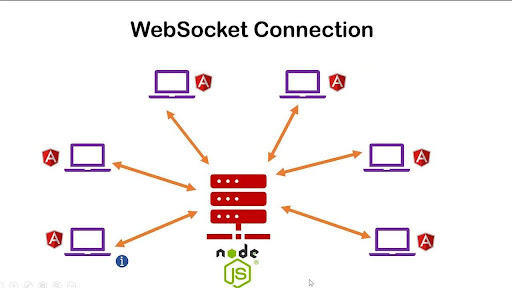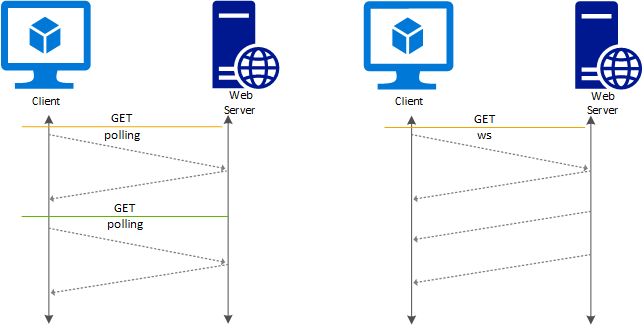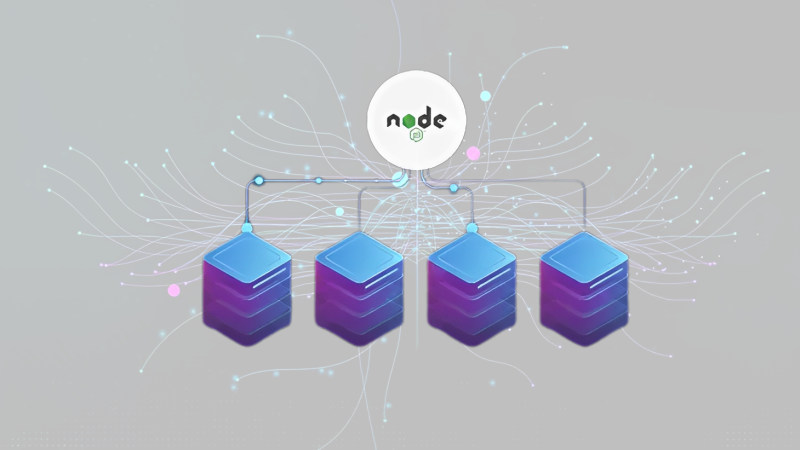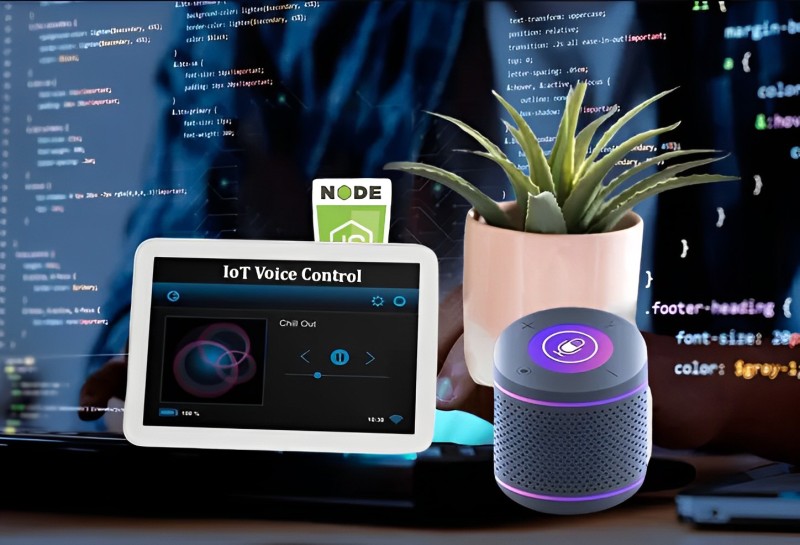Imagine an alternative world in which the web was not static but dynamic: where messages flew between screens instantly, updates came streaming in live, and interactions exchanged were seamless and instantaneous. That world exists within real-time web applications whose beating heart may often consist of NodeJS’ event-driven architecture combined with WebSockets bidirectional communication channels as their engines.

Why this dynamic duo? Explore why NodeJS web development services and WebSockets make such a successful combination for crafting exceptional real-time experiences a la Fred Astaire & Ginger Rogers!
NodeJS: Orchestrator of Lightning-Fast Interactions
Imagine NodeJS as the agile conductor orchestrating an easy dance of data exchange without exertion or strain. Its event-driven architecture allows it to manage multiple client requests concurrently without becoming bogged down like traditional single threaded servers; making Node ideal for applications where every millisecond matters such as chat rooms where messages must flow seamlessly across screens without gaps between messages being seen onscreen.
WebSockets Are The Conduit Of Constant Conversation

But every choreographer requires an audience, which is where WebSockets come into play. In contrast to HTTP requests which provide only short bursts of communication between your server and clients, WebSockets establish persistent two-way data flows allowing live updates, instant notifications, co-operative editing experiences or multiplayer gaming simultaneously with each update and notification sent back out through them. Our Tango Steps for Building Real-Time Apps — Step One by Step Two >>.
Now let’s lay out a plan to help you build your first real-time Tango with NodeJS and WebSockets:
- Establish Your Stage: Start by understanding your real-time needs: will they involve chat rooms, social network feeds or collaborative games? Understanding why an application exists will provide guidance when selecting technology solutions.
- Select Your Steps: Embark upon Your Dance: Choose libraries and frameworks to support your dancing steps – popular choices for NodeJS include Socket.io and Express.js while real-time real libraries like Pusher or PubNub are excellent real time channels that enable reliable data channels.
- Listen and Respond: Utilize event listeners on both client and server sides; when messages or actions occur, these listeners provide real-time updates and responses so as to keep conversations flowing seamlessly.
- Security in Focus: Don’t Forget Bouncers! Putting authentication and authorization protocols in place ensures only authorized users join your dance, keeping your application safe and secure. Best Practices to Achieve Peak Performance:
- Optimize Your Data Flow: For smooth real-time dance floors, remember these best practices for managing data flows: * Send Precise Payloads of Information to Decrease Bandwidth Usage and Server Load: Use JSON or binary formats when transmitting large payloads efficiently across networks or servers – keeping bandwidth costs and server loads under control by sending precise payloads of information as fast as possible.
- Manage Client Requests: Don’t overload your server! Implement rate-limiting policies so clients won’t flood applications with requests.
- Adopt Scalability: As your audience expands, ensure your infrastructure can keep pace. Cloud platforms and containerization technologies offer flexible scalability solutions.
- Thorough Testing: Never leave anything up for chance! Thoroughly evaluate and test your app for performance, latency and error handling before inviting others to dance along your tunes. Examples that Spark the Dance Floor:
Beyond the Hype: Demystifying TypeScript’s Power for Node.js Development
In this article, benefits of TypeScript for Nodejs projects. Discover how this language extension enhances code reliability, & the development experience.
Let’s experience NodeJS and WebSockets in action now:
- Chat Apps: From Slack to Discord, real-time communication has become essential to modern work and social interactions, powered by NodeJS/WebSockets instant messaging systems such as instant messenger chat services (IMTS/WCTS/GTC). These instant messages ensure instant discussions remain live.
- Social Network Feeds: Can you imagine Twitter without instant updates, or Facebook without live notifications? Social networks rely heavily on real-time capabilities of NodeJS and WebSockets for continuous streams of news and content streaming across their networks.
- Real-Time Gaming: Multiplayer games’ adrenaline rush relies on seamless exchanges of data among players; NodeJS and WebSockets enable this exchange while providing smooth movements, instant reactions, and syncronized gameplay; they bring virtual dance floors alive!
Join the Real-Time Revolution: NodeJS’ fast event-driven architecture and constant communication channel of WebSockets make Node a powerful toolkit for building extraordinary real-time experiences, so join its revolution. Take to the web’s dynamic nature; step onto its stage; and build apps bursting with life, interaction and the thrill of real-time connection!
Keep this in mind as a starting point, but continue exploring different libraries, exploring advanced features, and pushing the limits of what NodeJS and WebSockets can do. Let your creativity lead the way as you transform static web into real-time interaction!
Beyond Chat and Games: Unleashing the Full Potential of Real-Time with NodeJS and WebSockets
NodeJS and WebSockets may seem limited to chat apps and multiplayer games; their true potential lies beyond entertainment alone. NodeJS and WebSockets’ dynamic duo is capable of revolutionizing various industries while reinventing user experiences across the web through instantaneous interaction and collaboration.
Real-Time Applications Transforming Industries
- Finance: Imagine real-time market updates flickering across your screen or stock portfolios responding instantly to newsfeeds; real-time capabilities can provide traders with instantaneous insight and enhance trading platforms with dynamic visualizations that enhance trading platforms.
- Healthcare: Imagine patient monitoring systems sending vital signs data in real time or doctors receiving updates on surgical cases worldwide from surgeons across the world in real-time; such communication could enable remote consultation, optimize resource allocation and revolutionize patient care.
- Education: Imagine collaborative e-learning platforms where students can engage in real-time group projects or live Q&A sessions with experts – creating dynamic learning environments while forging global partnerships in real time!
- Science and Research: Imagine scientists collaborating in real time from remote locations by sharing lab data in real time or conducting experiments simultaneously, making real-time sharing an efficient tool that speeds scientific breakthroughs while streamlining research processes. With real-time sharing comes more than speed alone: the Symphony of Benefits.
NodeJS and WebSockets applications offer more advantages than speed alone when building real-time apps; users feel closer to applications that respond and update instantly, leading to greater loyalty and satisfaction for applications built this way. * Increased Engagement: Customers feel closer to applications which engage them instantly through rich user interactions that keep pace with them, leading to deeper emotional bonds being established between application users and the applications in use.
- Increased Productivity: Real-time collaboration shortens decision-making delays and streamlines workflows, increasing efficiency and output.
- Amelioration Data Visibility: Real-time data insights enable users to make more informed decisions quickly in response to changing circumstances, providing better decision support as well as speed of reaction times for faster responses and responsive actions.
- Globalized Experiences: Real-time communication allows global collaboration to occur more seamlessly than ever, creating truly connected communities.
Why To Outsource NodeJS Development? Benefits, Recommendations, and Guide
Aegis Softtech provides a quick development, portable, real-time application using outsource node.js development platform. Get free tips and Let’s discuss your node.js project.
Crafting the Future: Design Considerations for Building Reliable Real-Time Apps
- Security Is Key: Utilize strong authentication and authorization protocols to maintain data privacy and prevent unwarranted access.
- Data Optimization: Consolidate payloads into efficient transmission formats in order to reduce bandwidth strain and server load as much as possible.
- Scalability Matters: Select cloud-based architectures to accommodate growing user bases while preventing performance bottlenecks and performance bottlenecks.
- Leverage Automation: Take advantage of automation tools for tasks such as server health monitoring and error handling to streamline maintenance efforts and guarantee smooth operations.
NodeJS and WebSockets Are Tools; They Are Invitations
NodeJS and WebSockets offer more than tools; they invite us to envision an interactive web that pulses with life; applications which respond not just to clicks but to user interactions in real-time. With all this potential waiting to be unleashed through real-time technology, crafting experiences which create engagement while reinvention the web’s fabric are calling us forward with innovation in unison! Take Charge Now by Exploiting Real-Time Potential
These technologies hold great promise – take the Lead Now by harnessing its fullest potential while crafting experiences which create engagement; join forces of innovation which are revolutionizing and shaping web technology itself into what it really should be: unleash it for maximum potential unleashing real time technology while contributing innovation back in tandem.
Are You Ready To be Real-time Pioneers? Share Your Vision For Transformative Applications In the Comments Below! Let’s make the future an intriguing tapestry filled with instant connection and dynamic interaction!
Be mindful that this is only an initial framework; feel free to tailor and expand upon it as per the target audience by including specific examples, statistics or anecdotes relevant for them. Join me as we dance into the future of web together!
Beyond Buzzwords: Unleashing Real-Time Power with NodeJS and WebSockets
NodeJS and WebSockets technologies offer more than meets the eye; their true potential goes well beyond chat apps and flashy online games. Their collaborative power extends far beyond entertainment – to transform industries, redefine user experiences, and fill the web with instantaneous interactions and collaborative magic!
Imagine finance as vibrantly alive, where real-time market updates appear on screens and portfolios adjust instantly to newsfeeds. Traders gain instantaneous insights empowered by real-time data while platforms adapt into dynamic visualizations of shifting fortunes.
Healthcare has also taken to moving with real-time. Patient monitors transmit vital signs in real time to doctors worldwide who use live data as the backbone for consultations and resource allocation – streamlining consultations while optimizing resource allocation to bring unprecedented patient experiences. Live data serves as the lifeblood for modern medicine revolutionizing care delivery processes and patient experiences alike.
Education sheds its static exterior by welcoming real-time collaboration. E-learning platforms become vibrant hubs where students engage in live group projects with ideas flying like lightning across screens. Experts join this celebration by hosting live Q&A sessions, forging global partnerships, and inspiring minds worldwide.
Science and research break free of their lab walls thanks to real-time data sharing, with researchers from around the globe sharing live lab data together for instantaneous analyses that lead to instant insights and collaborative breakthroughs. What was once slow and siloed research now marches forward rapidly as scientists analyze live data with each other for instant insights that fuel breakthrough discoveries – it truly marks an innovation revolution!
Real-time is much more than speedy responses – it fosters deeper relationships where applications respond not only to clicks but to user interactions as a whole, increasing engagement, loyalty and satisfaction thanks to live responses and collaborative possibilities.
Productivity flourishes when working within real time constraints. Decision making delays vanish in favour of seamless workflows and collaborative environments; information becomes instantly accessible for instantaneous response to changing conditions to maximize output and minimize operational downtime.
Users gain unprecedented visibility as data’s raw power comes into view live and unimpeded, offering invaluable insight that informs decisions, anticipate trends and helps navigate life’s ever-evolving terrain with renewed assurance.
At its heart lies this real-time revolution’s most transformative aspect: shattering geographical barriers. Language barriers break down, differences become bridges of cooperation between communities, and collaboration bridges borders in creating vibrant tapestries of shared knowledge and collective advancement.
However, for such an exciting future to blossom requires careful cultivation. Security remains of utmost importance with strong authentication protocols in place to safeguard privacy and prevent unapproved access. Data, the fuel of this revolution must also be optimized; its payload streamlined while transmission formats efficient; to minimize strain and ensure smooth performance.
Scalability becomes the goal, with architectures built for adaptation and cloud-based solutions capable of meeting an ever-increasing user base. Automation takes center stage to guarantee smooth operations and maintenance costs savings while freeing human minds to pursue creative innovations more freely.
NodeJS and WebSockets aren’t just tools; they offer you the chance to explore, imagine and unleash the untapped potential of real-time technology. Take advantage of its immense power by crafting experiences that draw users in; embrace its revolutionary spirit to join a tide of innovation that changes web interactions from analytic data.
Are you ready to hire nodejs web developers lead real time pioneerly innovation? Share Your Ideas in the Comments Below Let’s join forces as real-time pioneers and turn our webs into vibrant places with instant connections and collaborative magic, turning the future into an incredible dance of possibilities!
Don’t take this as the final word; feel free to customize and personalize this content further for your target audience by including specific examples, statistics or anecdotes that resonate. Together we can shape the future of the web!
Unleashing Real-Time Power: 10 FAQs About NodeJS, WebSockets, and Beyond
- Real-time sounds interesting, but what exactly is it?
Think about applications that respond instantly with information gliding between platforms and users with seamless synchrony: that is real time interaction at its finest; creating dynamic interactions that feel alive!
- Is real-time just for chat apps and online games?
While chat and games do demonstrate real-time’s potential, its use extends far beyond entertainment – from live stock updates in finance, collaborative e-learning courses or medical monitoring! Real-time revolutionizes industries!
- Why do NodeJS and WebSockets go hand in hand so beautifully?
NodeJS’ multiple connection handling capabilities provide seamless multitasking while WebSockets open lines for data to stream freely back and forth – creating the power couple of real time communications, guaranteeing fast responses and seamless dialogues.
- Does Real-time App Development Seem Complex?
Not necessarily! Frameworks such as Socket.io make developing real-time applications much simpler, while there are plenty of resources at our fingertips – but, just like with any culinary endeavor, making an outstanding real-time experience requires learning and experimentation!
- Will these apps be expensive to create?
This depends entirely on their complexity and scale; cloud platforms and open-source tools provide cost savings while you work to craft real-time masterpieces!
- Are real-time applications secure?
Security must come first! Make use of strong authentication and authorization protocols to keep unwanted guests from joining in on the fun – think of it like creating a safe dance floor for users!
- What can I do to make sure my app keeps up with everyone dancing?
Scalability is of the utmost importance! Consider server setups or cloud solutions which can accommodate for increasing user numbers to ensure your app keeps moving fluidly even with an expanding audience.
- Can I just tack real-time features onto any app?
No. Carefully consider your app’s purpose and user needs before adding real-time features that add extra bells and whistles, not simply add unnecessary ones.
- Where can I witness real-time magic at work?
Look around! Real-time technology has already begun its transformational work on the Internet from live stock tickers and collaborative design platforms, inspiring thousands across it every day! Observe, study and let your creativity run wild!
- Are You Ready for Real-time Revolution?
Let Us Hear About it Below! Let’s build an interactive web throbs with dynamic interactions and collaborative possibilities!
Keep this in mind as just starting points: feel free to customize answers using specific examples, statistics or anecdotes relevant to your target audience. Let’s keep the real-time dialogue alive and inspire new innovative creations to move with the rhythms of tomorrow!
Read More:
As your software is growing larger, the potential of vulnerabilities is also getting bigger. Find out how Node.js identify and patch vulnerabilities that may exist.



